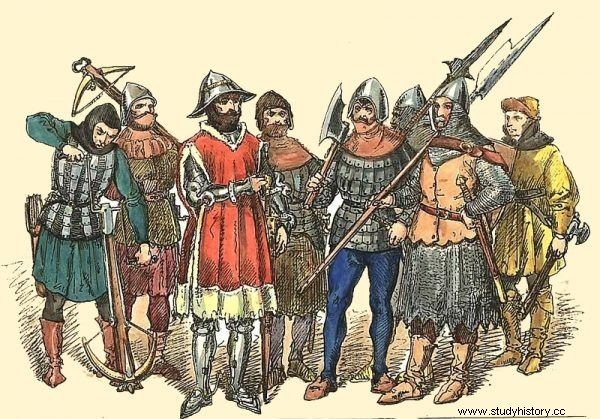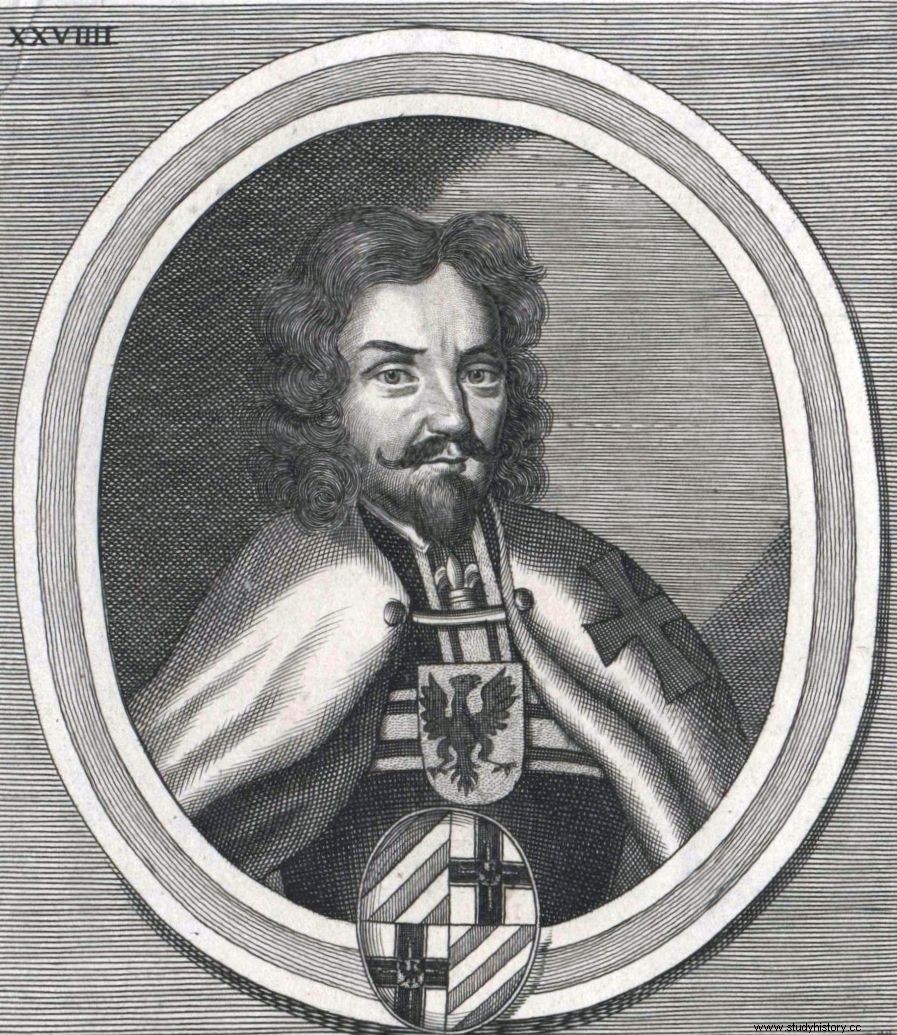The victory at Grunwald did not break the Teutonic power. Another war broke out in 1454. The Poles expected an easy victory, but they were sorely disappointed. From the very beginning of the conflict, they suffered a humiliating defeat.
In the middle of the 15th century, the Prussian nobility and burghers living in the territory of the Teutonic Order were fed up with the rulers of the Order of the Hospital of Our Lady of the German House in Jerusalem. Numerous wars with Poland led to the devastation of large swaths of the country and its impoverishment, while the masters from Malbork were still demanding new taxes.
Jealous neighbors
The merchants and knights living in the Kingdom of Poland fared better and better, and the Teutonic subjects looked at them with envy. They were also envied by the rulers of the Jagiellonian dynasty, who were much gentler and liberal than the strict masters of the Order. In 1440, the most determined Prussian oppositionists, mainly townspeople from Toruń and Chełmno, founded the Prussian Union. The aim of the organization, which quickly covered the entire region, was to protect the inhabitants against the Teutonic oppression.

At Chojnice, the Teutonic Knights took bloody revenge for Grunwald. The illustration shows the painting by Fritz Grotemeyer "The Battle of Chojnice 1454".
The conflict between the union and the Teutonic master Ludwig von Erlichshausen finally led to an armed uprising. In February and March 1454, the Prussian opposition seized the entire country except for three castles in the heart of the country, including the mighty capital Malbork.
A letter was sent to the Polish king Kazimierz Jagiellończyk with a request to take power over Prussia. The monarch, who had been secretly negotiating with the rebels for some time, agreed, of course. On the basis of the act of incorporation issued by him, the lands of the Teutonic Order were to be incorporated into Poland.

Kazimierz Jagiellończyk willingly agreed to the proposition of the Prussian townspeople. He was expecting an easy victory.
Contrary to what one might think, the Teutonic Knights were not in a lost position at all. They had money to hire mercenaries with. Erlichshausen's energetic nephew, Henryk von Plauen, was already in full swing for this purpose in Germany.
He quickly gathered mercenary troops and, going to the rescue of his uncle, reached Chojnice in the western part of the Teutonic state. The fortress was recaptured from the enemy's hands, which significantly improved the strategic situation of the order. Holding Chojnice, von Plauen controlled the road from Brandenburg, through which subsequent mercenary units were to arrive to help Malbork.
Battle of Chojnice
Soon, around 20,000 Polish army under the command of Kazimierz Jagiellończyk also arrived in the vicinity of the city. For the most part, it consisted of a knight's cavalry convened for war as part of a mass mobilization. Polish knights joined the expedition extremely reluctantly.
However, they saw it as a good opportunity to put pressure on the monarch in order to implement their political demands. In Cerekwica, where the army was camped, the Jagiellonian had to make a promise that neither he nor subsequent kings would call a mass mobilization or levy taxes without the consent of the noble assemblies.
When the nobility was celebrating the success, more troops of the Teutonic invasions approached from the west. This time it was a whole army of about 15,000 men. On September 18, 1454, both troops met at the Chojnice castle, still occupied by von Plauen. Poles and Teutonic Knights were separated by an oblong lake through which a dike ran. Whoever wanted to attack had to throw troops across this narrow strip of land.
The Teutonic commander, Bernard Szumborski, was cautious, ordering to set up a defensive fleet of carts, the so-called wagenburg. The Poles, on the other hand, decided to attack. They were rested, as they were the first to reach Chojnice and managed to sleep there overnight, while the enemy was just marching towards the city. It could be assumed that the less numerous army of mercenaries, exhausted by the march, could be easily defeated.
The first charge was impressive indeed. The Polish heavy cavalry banners launched an attack on the dike and defeated the enemy cavalry in the initial fight. Szumborski was captured, two other Teutonic commanders were killed. The Jagiellończyk's ride, drunk with success, headed for the enemy fleet to finish off the enemy.
Here, however, a scythe hit a stone. The infantry showered the attackers with a barrage of crossbow bolts, repelling the attack. Meanwhile, von Plauen took a surprising action on the opposite bank. About 500 knights galloped out from behind the suddenly opened gate of the Chojnice castle and headed straight for the Polish camp. The Lechites made a fatal mistake, completely forgetting the enemy lurking in the fortress!

In the first phase, the Battle of Chojnice was successful for the Poles, but the situation was reversed. The illustration shows Polish troops from the second half of the 15th century according to Jan Matejko.
Knights of von Plauen fell between the tents of the Jagiellonian camp, causing complete chaos in it. King Casimir wanted to defend himself, but the courtiers kidnapped him and started to flee. The Poles on the western shore of the lake realized with horror that the enemy had hit the camp and found himself behind the army. This caused a panic that engulfed Jagiellon's army like a fire. The chaotic mass of knights started back across the causeway, eager to break free from the trap. Teutonic mercenaries rushed after her, hitting whoever had fallen.
Over three thousand Poles died in the slaughter, including the flower of the then Jagiellonian knighthood, headed by the son of the famous Zawisza the Black - Jan Zawisza from Rożnów. A great number of dignitaries and commanders were taken prisoner. The defeat was total and absolute.
Having rested after the battle, Szumborski and von Plauen set off to help Malbork. Throughout Prussia, the cities passed back one by one to the Teutonic side. Nobody expected such a dramatic turn of events.
Will you buy, my lordship, Malbork?
King Kazimierz was saved from total defeat by the order's treasury. The Teutonic Knights simply overinvested and had no more money to pay for the thousands of mercenary soldiers. When master von Erlichshausen admitted that there was nothing to compensate for all mercenaries for the last period of service, the hired killers became furious. Kasper Nostitz, commander of the rota of Czechs and Silesians, publicly pulled the leader of the Teutonic State by the beard, threatening to kill him.

Grand Master Ludwig von Erlichshausen gave Malbork a pledge to unpaid mercenaries, who in turn sold it to Kazimierz Jagiellończyk.
Erlichshausen was desperately looking for a way out of the situation and finally agreed to an interesting idea:he agreed to pledge castles and cities to mercenaries. Thus, Malbork was placed at the disposal of Oldrzich Czerwonka, the commander of the three-thousand-strong detachment of soldiers defending it.
Czerwonka waited a while, but because the money from the master still did not come, he decided ... to sell the fortress to the Polish king. After long negotiations, in 1457 a bargain was made for 178,000 Hungarian ducats for Malbork and two smaller towns. The Teutonic Knights had to move their capital to Królewiec, and the Polish crew made themselves at their impressive castle.
If the Jagiellonian had a sufficiently large budget, he could buy all the castles from mercenaries, seizing all of Prussia this way. However, since he did not have such means, it was necessary to think about other ways to defeat the enemy.
***
Find out more:
- Biskup M., The Thirteen Years' War and Poland's return to the Baltic in the 15th century , National Publishing Agency, Krakow 1990.
- Bogucka M., Kazimierz Jagiellończyk and his times, Universitas, Krakow 2009
- Bogacki M., Weapons of Polish troops in the Middle Ages , Replica, Zakrzewo 2009
- Górski K., Pomerania during the Thirteen Years' War , Napoleon V Publishing House, Oświęcim 2014.
- Nowaczyk B., Chojnice 1454 - Świecino 1462 , Bellona, Warsaw 2012.
- Sikorski J., Outline of the history of general military until the end of the 19th century. , MON Publishing House, Warsaw 1972.
